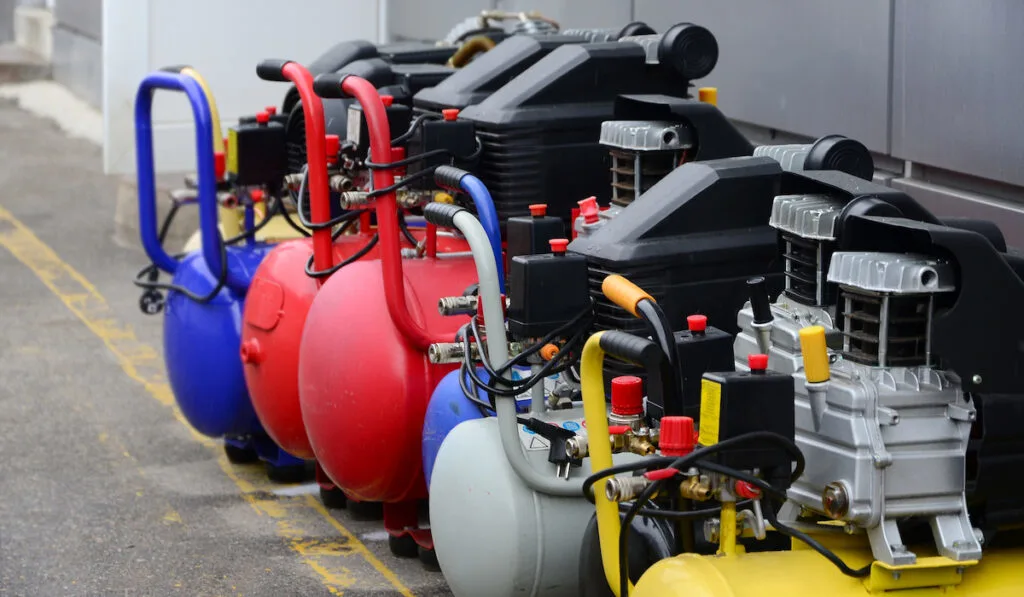*This post may have affiliate links, which means I may receive commissions if you choose to purchase through links I provide (at no extra cost to you). As an Amazon Associate, I earn from qualifying purchases. Please read my disclaimer for additional details.
Air compression is a complex subject that includes many measurements, such as PSI, HP, and CFM. These tools are used more commonly than you may imagine and even in household applications where you may require an increase of CFM in your air compressor.

How to increase CFM on air compressor? It can be done by decreasing the pressure in the tank, so there is room for the CFM (Cubic Feet Per Minute) to increase the delivery of air. You can increase the CFM by:
- Decreasing the regulator pressure to increase CFM
- Connecting two air compressors for CFM that exceeds capacity.
The higher the CFM, the more appropriate it will be for a larger job. Use this quick read to understand how to measure your initial reading and increase the CFM for an air compressor’s optimal functions.
Table of Contents
What Is CFM?
CFM stands for the Cubic Feet per Minute and represents the speed at which the volume of air flows out of that tank or air compressor.
For example – A tank with 10 CFM, allows for 10 cubic feet of air to emerge per minute.
Keep in mind that the tank will need to align with that air compressor’s CFM, so all figures need to correlate depending on the type of job you are doing, and the air compression you require. This will often be the most optimal method to guarantee that your CFM is at the level it needs to be, without the additional work of increasing it.
Another important abbreviation in the compression world is PSI (Pounds Per Square Inch), which will measure the amount of force within the air compressor. To offer you a scale of reference, power tools will most commonly require a PSI between 40 and 90.
Essentially, the CFM will measure the volume, while the PSI will measure the tank’s pressure. These figures together will tell you everything you need to know about a given air compressor.
How to Check Compressor CFM
Before you think of increasing the CFM of your air compressor, you must first understand the preliminary reading and if an increase is necessary.
The steps to check the current compression of your tank will be as follows:
- First thing to do is turn the power off to your tank by turning the knob attached to the opening.
- Drain the air, (and you may want ear plugs for this step).
- Read the tank and see what level the initial reading is. This reading will determine how much you will need to fill your tank based on its level of capacity.
- To start filling your tank, set a stopwatch. You will press the timer on the stopwatch at the exact time that the tank is turned back on. You are measuring how many minutes it takes to fill up the tank. It may take around 10 minutes to fill up a 60-gallon tank.
- Now it’s time to do some math:
You are seeking to change the metric of gallons to cubic feet.
For example – If you have a 60-gallon tank with 12.5 CFM at 100 PSI (Common Size) – You can then take your tank size (Multiplied by) the air pressure. So –
If your tank size was 8.04 cubic feet (Multiplied) 160 Air Pressure = 1286.4
(Divided By) 13.9 which is the atmospheric pressure (If you’re at sea-level it is at 14.7)
= 92.54 Cubic Feet of Air in Tank
Divide this number by the number of minutes it took for your tank to completely fill up (the number on your stopwatch).
In this case, if it took 9.5 minutes (9 minutes and 30 seconds) then –
92.54 Cubic Feet of Air in Tank (Divided by) 9.5 minutes = 9.7 CFM @ 160 PSI
Think of your tank as a balloon. The air had to be placed in the tank initially before pressure could build up. The speed at which that air comes out of the balloon would measure the CFM.
Many believe that a higher CFM provides more air, but aside from the PSI, the main thing you need to pay attention to is the Duty Cycle and Rating on your tank.
Understanding the Duty Cycle and Rating
Yes, a compressor with a larger CFM rating will be optimal for larger projects and jobs; however, understanding your duty cycle will lend itself to a successful process.
The Duty Cycle and rating on your tank will signify the balance of their ‘on/off’ functions.
In essence, if you see a rating that says:
- 50/50 duty cycle – This means it will run half of the time.
- 75/25 duty cycle – This means it will run 75% of the time.
And so on. Keep all of these figures in mind while you:
- Gather your tank’s original CFM and determine if an increase is necessary
- Consider the type of task you are attempting to complete
Once you have all this information you can increase from there.
How to Increase CFM on Air Compressor
Now that you’ve determined your tank’s present condition, you are able to increase the CFM. There are limited methods to increasing the CFM, but two techniques are:
Technique #1 Decreasing the Regulator Pressure
You shouldn’t push a tank past its capabilities or power limits or you risk damaging the compressor. Therefore, you must turn down the regulator pressure to balance the increase in CFM you’re evoking. The steps to do this will be simply:
- Turning down the regulator pressure (PSI) based on the mathematics of your CFM. Many suggest turning it down to its lowest setting that is still functional.
- Increase the CFM as you release pressure, do so gradually, and do not exceed your tank’s power setting.
You are reducing the speed and time, but this will allow for a lower pressure inside of your tank, as well as an increased CFM.
Technique #2 Connecting Two Air Compressors
The previous method will not be able to exceed the maximum power limit of that compressor, but if you do want to exceed it, you will need multiple compressors.
Think of it this way – A 5 CFM tank + a 5CFM tank = a 10 CFM tank.
The steps to do so are as follows:
- Purchase two compressors and two fitting hoses as well as an additional third hose to link them.
- Regarding the third hose that links them, you will want a hose which includes multiple holes that will release some of the pent-up energy and compression to prevent tank-damage. You should seek a hose with two holes for input air and one hole for output.
- The output on the third hose will connect and link the CFM of the two tanks.
Verdict on Increasing Air Compression
As mentioned, there aren’t many techniques for increasing the CFM because you don’t want a tank that is highly-pressurized.
There are cases in which a highly-pressurized compressor explodes, so although this piece is about offering you solutions to increase the CFM, we don’t recommend it.
Not only is it adding another item to your to-do list, but it is also dangerous and can provoke any manufacturing defects that wouldn’t have been otherwise activated.
Therefore, it is advised to:
- Purchase additional air compressors and use an increase of quantity, instead of seeking to overpower an individual tank. Or –
- Purchase a tank with the proper CFM
In Conclusion
You can increase the tank’s pressure, but this is less efficient than beginning with a tank that can already offer the power limits you need. For all of those seeking to manipulate their tank’s air compression, we would advise you to match the CFM to the compressor and the task as accurately as possible.
By purchasing the right CFM level for the job, this will prevent you from needing to increase the CFM in the first place.

Tracy
Monday 31st of May 2021
Not only is it adding another item to your to-do list, but it is also dangerous and can provoke any manufacturing defects that wouldn’t have been otherwise activated.